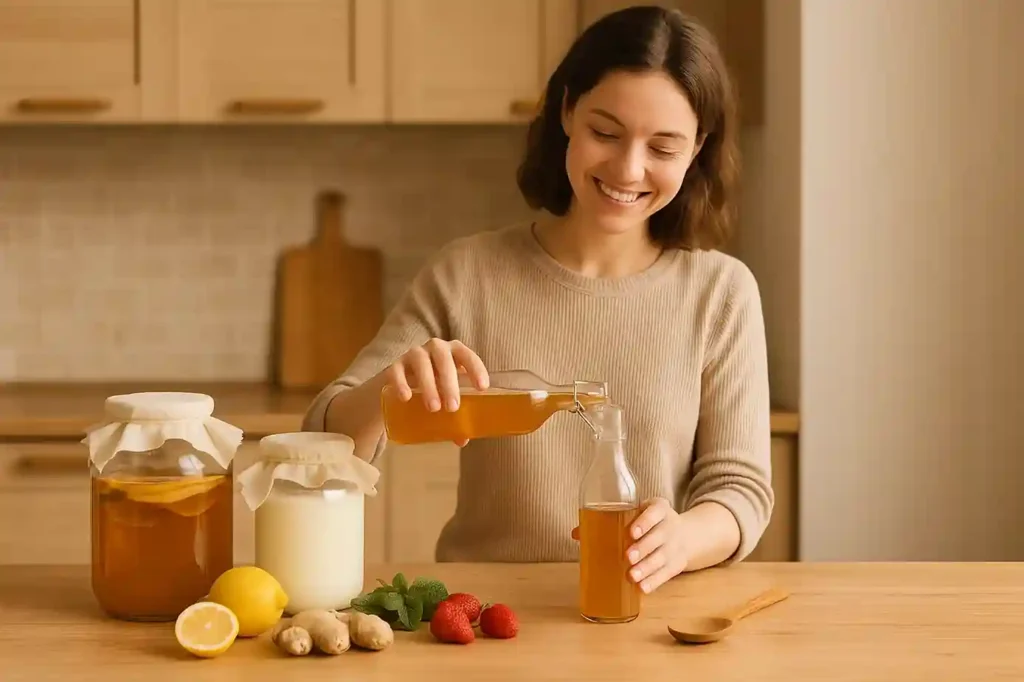Fermented drinks have been enjoyed for centuries for taste and health. Around the world, people discovered that tea, milk, grains, and fruits could be transformed into tangy, refreshing beverages. These drinks carried flavor and natural benefits that kept traditions alive for generations.
In the U.S., homemade fermentation is seeing a revival. More people want alternatives to sugary sodas and are turning to natural, probiotic-rich drinks. Store shelves may be full of kombucha and kefir, but making your own brings more freedom. At home, you decide the flavors, sweetness, and strength. It’s affordable, creative, and fun to share with family and friends.
This guide will show you how to make fermented drinks at home in simple, safe, and enjoyable steps. You’ll learn the tools you need, how the process works, and easy recipes to try. With a little patience, you can create refreshing drinks that are both healthy and unique to your taste.
What Are Fermented Drinks?
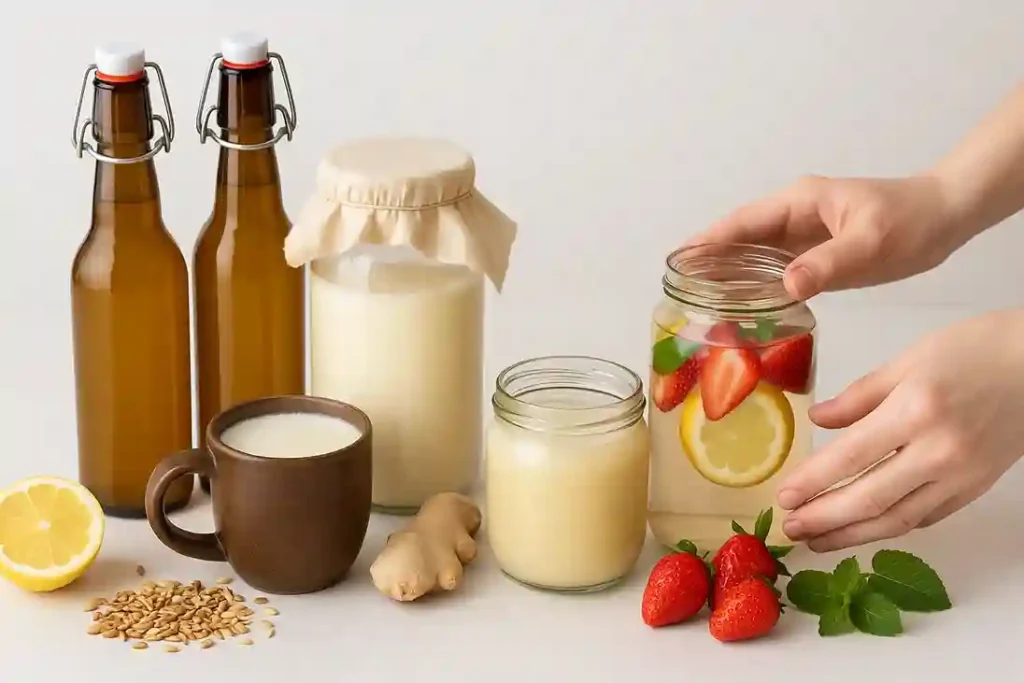
Fermented drinks are beverages created through natural fermentation. In this process, friendly bacteria or yeast consume sugars and turn them into acids or bubbles. The result is a drink that feels lively, tangy, and full of character. Common examples include kombucha, kefir, ginger beer, and kvass. Each drink has its own history and unique flavor. Kombucha starts with tea and a SCOBY, while kefir relies on grains. Ginger beer uses natural yeast for fizz, and kvass comes from bread or grains.
The appeal of fermented drinks goes beyond taste. They supply probiotics that may support gut health. They also connect us with food traditions that go back centuries. Each sip is a reminder of how simple ingredients can become something both healthy and enjoyable.
Why Make Fermented Drinks at Home?
Save Money
Store-bought fermented drinks can be expensive. A single bottle of kombucha often costs three to five dollars in U.S. stores. When you make it at home, the same amount of money can produce a whole batch. That means several bottles for the cost of one, without sacrificing taste or quality.
Control Ingredients
Homemade fermented drinks give you full control. You choose the sweetness level by adjusting sugar during fermentation. You can experiment with fruits, herbs, and spices to create unique flavors. If you prefer, you can select organic or locally sourced ingredients for a fresher, healthier option.
Enjoy a Fun Hobby
Fermenting is more than just a kitchen task. It becomes a creative hobby where you can play with taste, fizz, and texture. Each batch feels like its own experiment, with small changes leading to new results. The process is hands-on, rewarding, and fun to share with family and friends.
Essential Tools and Ingredients
Making fermented drinks at home doesn’t require fancy equipment. A few simple items are enough to get started.
| Item | Purpose | Notes |
|---|---|---|
| Glass Jars | Hold the fermenting liquid | Wide-mouth jars work best |
| Clean Cloth | Covers the jar | Allows airflow while keeping dust out |
| Rubber Bands | Secures the cloth | Simple and reusable |
| Bottles with Tight Lids | Store finished drinks | Helps build natural fizz |
| SCOBY | Starter for kombucha | Symbiotic culture of bacteria and yeast |
| Kefir Grains | Starter for kefir | Works with milk or water |
| Wild Yeast | Natural fermenter | Found in fruits, ginger, or air |
| Fresh Ingredients | Base for flavor | Tea, milk, fruit, or ginger |
| Sugar | Food for fermentation | Adjust amount for sweetness and strength |
Tip: Keep all tools clean and sterilized. Good hygiene ensures safe fermentation and prevents spoilage.
Step-by-Step Guide
Choose Your Base
Choosing the right base is the first step in making fermented drinks. Each liquid offers its own flavor, texture, and benefits. Your choice will shape the final result.
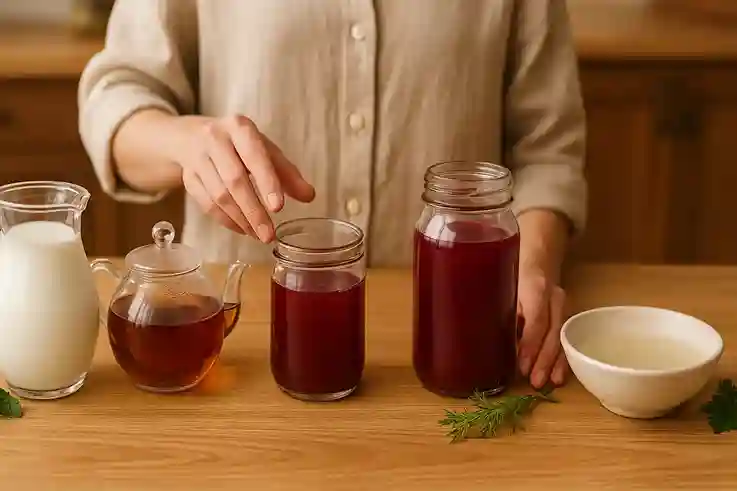
Tea
Tea is the traditional base for kombucha. Black tea provides strong flavor, while green tea gives a lighter taste. Herbal teas can be used but may produce weaker results unless blended with true tea leaves. The tea supplies nutrients for the SCOBY and sets the stage for a tangy, fizzy drink.
Milk
Milk is the base for kefir, a creamy and probiotic-rich option. Cow’s milk is most common, but goat’s and sheep’s milk work too. Non-dairy alternatives like coconut or almond milk can also ferment, though they may need extra care. Milk proteins and sugars feed kefir grains, creating a smooth, yogurt-like beverage.
Fruit Juice
Fruit juice fermentation creates bright, refreshing drinks. Apple, grape, and pomegranate juices work especially well. Juice provides natural sugars for yeast and bacteria to consume. The result is a tangy, slightly fizzy drink that keeps the fruit’s natural flavor. This option is a good choice for those who prefer sweeter results.
Ginger Water
This water forms the base for homemade ginger beer. It starts with grated ginger, sugar, and water. Over time, the mix encourages wild yeast to grow, creating a “ginger bug.” This culture drives fermentation and produces a spicy, refreshing drink. This water is one of the easiest ways to start fermenting at home.
Add Starter Culture
To transform a simple liquid into a lively fermented drink, you need a starter culture. These living organisms begin the process of fermentation by feeding on sugars and releasing acids, gases, and probiotics. Different starters match different bases, and each creates a unique result.
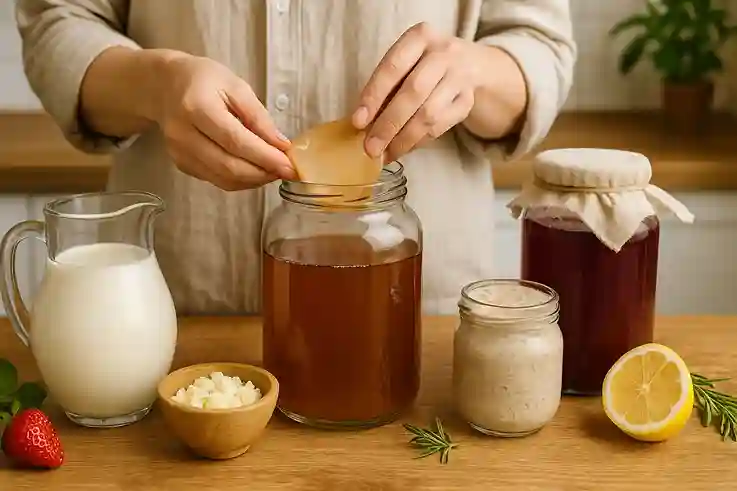
SCOBY for Kombucha
A SCOBY (Symbiotic Culture of Bacteria and Yeast) is the heart of kombucha. It looks like a rubbery disc that floats on top of tea. The bacteria and yeast inside the SCOBY consume the sugar and produce a tangy, slightly fizzy drink. Over time, each batch can grow new layers of SCOBY, which can be shared or used in future brews.
Kefir Grains for Milk or Water
Kefir grains are soft, jelly-like clusters filled with beneficial bacteria and yeast. When added to milk, they create a creamy, yogurt-like drink rich in probiotics. Water kefir grains work in sugar water or fruit juice, producing a lighter, refreshing drink. Grains can be reused indefinitely with proper care, making them a sustainable starter.
Wild Yeast from Ginger or Fruit
Wild yeast is a natural starter that comes from fresh ingredients. A “ginger bug,” made from grated ginger, sugar, and water, captures wild yeast from the environment. Fermenting fruit can also release natural yeast. These wild starters create lively drinks with a rustic, homemade character. They are flexible, but they require patience and regular feeding to stay active.
Fermentation Time
Fermentation is where the magic happens. Once your base and starter culture are combined, the drink begins to transform. Patience during this stage is key.
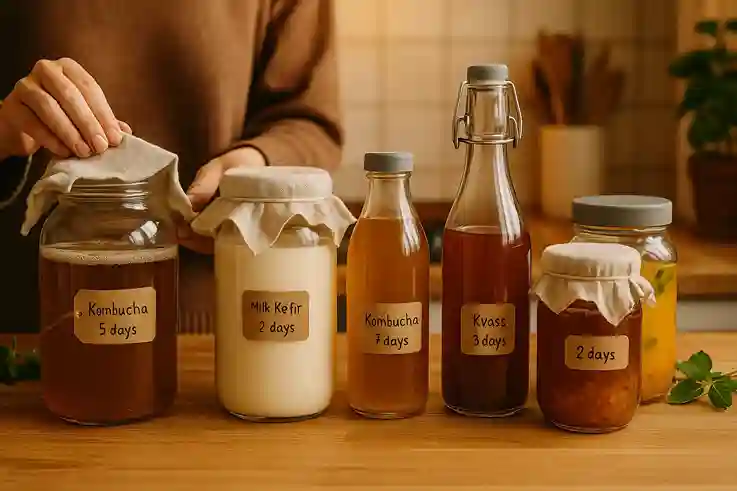
Typical Fermentation Time
Most fermented drinks take between two and ten days at room temperature. Kombucha often needs 7–10 days, while kefir is ready in just 24–48 hours. Ginger beer usually falls in the middle, around 3–5 days. The exact time depends on the base, the culture, and the temperature of your kitchen.
Flavor Development
Fermentation time directly affects taste. Shorter fermentation leaves the drink sweeter, since more sugar remains. Longer fermentation creates a tangier, more acidic flavor with less sweetness. You can sample a small amount each day to decide when the flavor is just right for you.
Best Conditions
Room temperature between 68–75°F works well for most ferments. Keep jars in a dark or shaded spot to avoid direct sunlight, which can stress the culture. Cover the container with a clean cloth to allow airflow while keeping out dust and pests.
Flavor and Bottle
Once the first fermentation is complete, it’s time to make your fermented drink taste unique. This stage is where creativity shines.
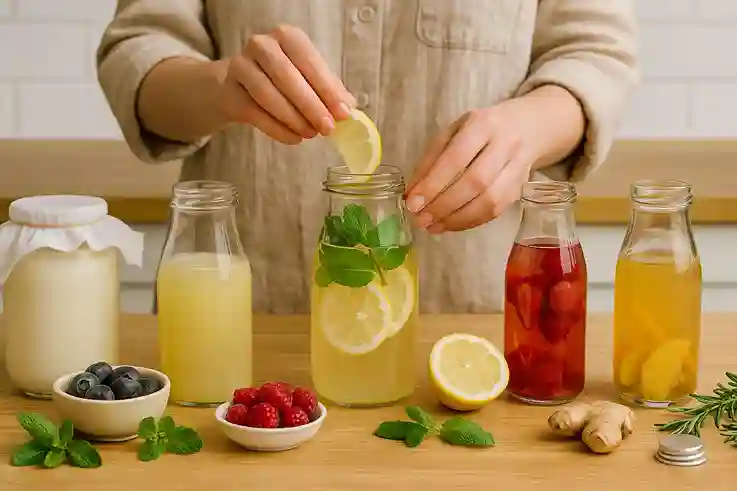
Add Fruits, Herbs, or Spices
Fresh fruit brings natural sweetness and color. Citrus slices, berries, or apple pieces are popular choices. Herbs like mint, basil, or rosemary add a refreshing twist. Spices such as ginger, cinnamon, or cloves can create warmth and depth. Small additions are best—too much can overpower the drink.
Use Clean Bottles
Transfer the flavored liquid into glass bottles with tight-sealing lids. Swing-top bottles are a common choice because they hold pressure well. Always wash and sterilize bottles before use to prevent contamination.
Lock in Freshness
Sealing the bottles traps natural carbonation, keeping the drink fizzy and flavorful. This step also prepares the brew for a second fermentation if you want extra bubbles. Store bottles upright to reduce pressure on the caps.
Second Fermentation
The second fermentation is optional, but it’s what gives many fermented drinks their sparkle and extra flavor.
How Long to Wait
After bottling, seal the containers tightly and let them sit at room temperature for one to three days. During this time, yeast consumes leftover sugars and produces carbon dioxide. The trapped gas builds natural fizz.
Flavor Development
This stage also allows flavors from added fruits, herbs, or spices to blend into the drink. A short second ferment creates light bubbles, while a longer one deepens the taste and increases carbonation.
Safety First
Pressure can build quickly in sealed bottles. Open them daily to check the fizz and release excess gas if needed. Swing-top bottles are sturdy, but it’s wise to handle them carefully.
Chill Before Drinking
Once the drink reaches your preferred level of bubbles, place the bottles in the fridge. Cold temperatures slow fermentation and keep flavors stable. Enjoy your homemade fermented drinks chilled and refreshing.
Safety Tips for Fermenting at Home
Making fermented drinks at home is safe when done with care. A few simple habits will help protect both flavor and health.
Watch for Spoilage
Check your jars daily to make sure the fermentation is healthy. If you notice mold on the surface, a slimy film, or a foul odor, the batch should be thrown away immediately. Healthy fermentation usually smells tangy, slightly sour, or yeasty, but it should never smell rotten or putrid. When in doubt, it’s safest to discard and start again with clean, sterilized jars.
Keep Containers Sterilized
Clean tools and jars are essential for safe fermentation. Wash everything in hot, soapy water and rinse thoroughly to remove residue. Many home brewers go a step further by boiling their jars or running them through a dishwasher cycle. Keeping equipment sterile reduces the risk of harmful bacteria and helps each batch of fermented drinks turn out fresh and safe.
Choose the Right Storage Spot
Ferments do best in a cool, dark space where conditions stay steady. Direct sunlight can stress the cultures and slow or disrupt the process. A pantry shelf or a quiet spot on the kitchen counter, away from stoves or heat sources, usually works well for healthy fermentation.
Handle Bottles with Care
Pressure can build quickly inside sealed bottles during fermentation. Always open them slowly to release gas without spilling. For extra safety, open bottles over a sink or place a towel underneath to catch any foam or overflow.
Popular Types of Fermented Drinks You Can Try
Kombucha
Kombucha is a tangy, tea-based drink made with a SCOBY, a living culture of bacteria and yeast. It begins with sweetened black or green tea and ferments into a bubbly, refreshing beverage. The process transforms sugar into acids and carbonation, giving kombucha its signature tang. Many brewers add fruits, herbs, or spices during a second fermentation, which enhances flavor and creates extra fizz.
Milk Kefir
Milk kefir is creamy, smooth, and packed with probiotics. It’s made by adding kefir grains—clusters of beneficial bacteria and yeast—to milk. During fermentation, the grains break down natural sugars, creating a yogurt-like drink that’s lighter to sip. The flavor is tangy, the texture is silky, and the drink is easy to customize with fruit or spices. Milk kefir is a great choice for anyone who enjoys dairy-based ferments and wants a quick, reliable option.
Water Kefir
Water kefir offers a lighter, fruitier option compared to milk-based ferments. Instead of dairy, it uses water kefir grains—small, crystal-like clusters of bacteria and yeast—placed in sugar water or fruit juice. During fermentation, the grains consume the sugar and create natural fizz, leaving behind a refreshing, slightly sweet drink. Water kefir is versatile and works especially well with fruit infusions. Citrus slices, berries, or tropical fruits like pineapple and mango give it a bright, lively flavor that’s perfect for warm days.
Ginger Beer
This beer is a spicy and refreshing fermented drink with a bold kick. It begins with a “ginger bug,” a starter made from fresh ginger, sugar, and water. As the mixture ferments, natural wild yeast develops, producing carbonation and probiotic benefits. The result is a fizzy drink with warmth from the ginger and just enough sweetness to balance the spice. Many home brewers enjoy customizing ginger beer with lemon, lime, or even spices like cloves and cinnamon for extra depth.
Kvass
Kvass is a traditional Slavic fermented drink made from bread or grains. It often uses rye bread, which gives the brew its malty, earthy character. The fermentation process produces mild carbonation, creating a drink that feels both hearty and refreshing. Kvass has been enjoyed for centuries across Eastern Europe as a household staple. While it is less common in the U.S., it’s valued for its deep history and unique flavor profile. Some variations also include fruits, herbs, or beets for added taste and color.
Quick Comparison Table
| Drink | Base Liquid | Starter Culture | Typical Fermentation Time | Flavor Profile |
|---|---|---|---|---|
| Kombucha | Sweetened tea | SCOBY | 7–10 days | Tangy, fizzy, customizable |
| Milk Kefir | Dairy milk | Kefir grains | 1–2 days | Creamy, tangy, probiotic-rich |
| Water Kefir | Sugar water/juice | Water kefir grains | 2–3 days | Light, fruity, slightly sweet |
| Ginger Beer | Ginger water | Ginger bug (wild yeast) | 3–5 days | Spicy, refreshing, lightly fizzy |
| Kvass | Bread/grains | Natural fermentation | 2–4 days | Malty, earthy, mild carbonation |
Health Benefits of Fermented Drinks
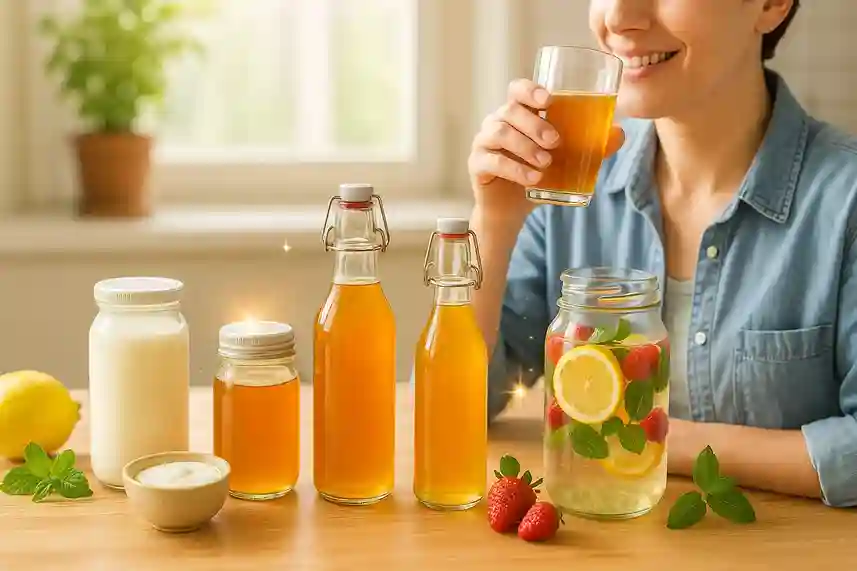
Support Gut Health
Fermented drinks are naturally rich in probiotics, the beneficial bacteria that help balance the gut microbiome. A healthy gut supports smoother digestion, reduces bloating, and may improve how well the body absorbs nutrients from food. Regularly drinking probiotic-rich beverages can make the digestive system more resilient and comfortable.
Boost the Immune System
A strong gut is closely linked to overall immune function. The probiotics found in fermented drinks help maintain this balance by supporting the body’s natural defenses. A healthier gut environment may improve the way the immune system responds to infections and can also help reduce inflammation. Regular consumption can be a simple way to give your body extra support.
Provide Natural Nutrients
Many fermented drinks provide natural vitamins and minerals along with probiotics. Milk kefir is a good source of calcium, protein, and B vitamins, which support bone strength and energy levels. Kombucha contains organic acids and small amounts of B vitamins that may help metabolism and detox support. Kvass, made from grains or bread, can offer B vitamins and trace minerals, adding to its nutritional value. These drinks deliver more than flavor—they also contribute useful nutrients to a balanced diet.
Aid Hydration Without Excess Sugar
Unlike sodas, fermented drinks are only lightly sweet and not overloaded with added sugars. During fermentation, much of the sugar is consumed by bacteria and yeast, leaving behind a tangy flavor and natural fizz. This makes them refreshing to drink while keeping sugar content lower than most soft drinks. Choosing fermented options provides the enjoyment of carbonation without the health concerns tied to overly sweet beverages.
Offer Variety and Tradition
Fermented drinks connect modern households with centuries-old food traditions. Families across the world have relied on these beverages for nourishment, refreshment, and community for generations. From kombucha in Asia to kvass in Eastern Europe, each drink carries cultural history while offering unique flavors and natural health benefits. Brewing them at home keeps these traditions alive while adding a personal, creative touch.
Promoting a Healthy Microbiome with Food and Probiotics — VA.gov
This page explains how fermented foods contain beneficial bacteria (probiotics) that support microbiome health, digestion, immune function, and more.
Frequently Asked Questions
Conclusion
Fermented drinks are simple to make, healthy to enjoy, and deeply rooted in tradition. From kombucha and kefir to ginger beer and kvass, each option brings unique flavors and natural benefits. With just a few tools, some patience, and a little creativity, you can craft refreshing drinks that fit your taste and lifestyle. Making them at home saves money, gives you control over ingredients, and turns fermentation into a fun, rewarding hobby.
Now that you know how easy it is to get started, why not try brewing your first batch this week?
Experiment with different bases, flavors, and fermentation times until you find your favorite.
Share your experiences and recipes in the comments we would love to hear which fermented drink you’ll make first.

Alexia Greene is a health blogger dedicated to making wellness simple, practical, and accessible for everyone. With a strong background in nutrition and healthy living, she writes about balanced diets, fitness tips, and mindful habits that support long-term well-being. Alexia’s mission is to empower readers with trustworthy information and actionable steps they can use in their everyday lives.
When she’s not writing, Alexia enjoys cooking wholesome meals, practicing yoga, and exploring new ways to live a healthier lifestyle. Her approachable style and evidence-based advice make her a trusted voice in the world of health and wellness blogging.
